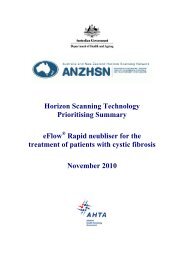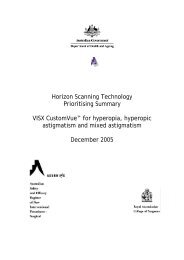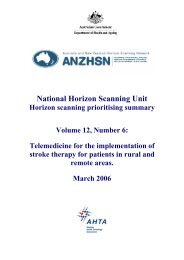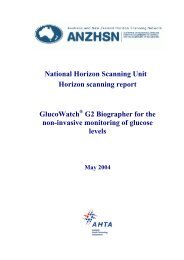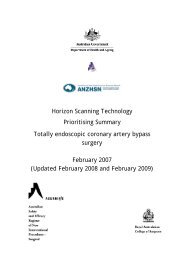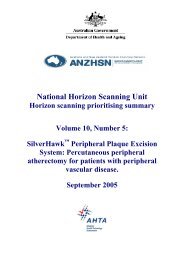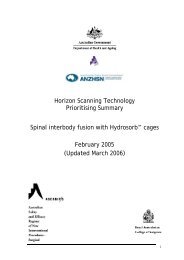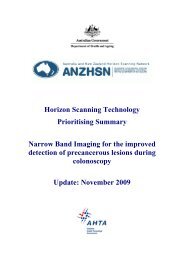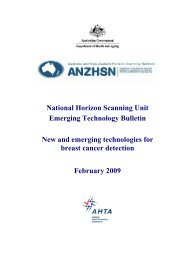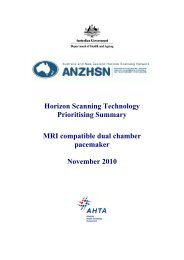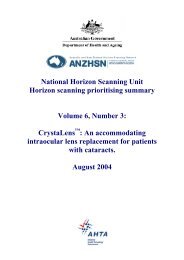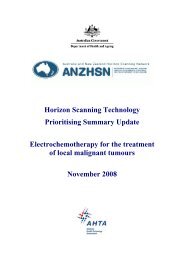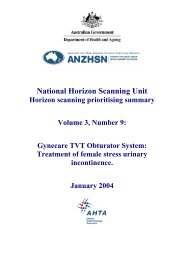Totally endoscopic coronary artery bypass surgery (Update)
Totally endoscopic coronary artery bypass surgery (Update)
Totally endoscopic coronary artery bypass surgery (Update)
You also want an ePaper? Increase the reach of your titles
YUMPU automatically turns print PDFs into web optimized ePapers that Google loves.
In the study by Mohr et al. (2001), a subgroup of the patient cohort (n = 35) underwentTECAB to anastomose the left internal thoracic <strong>artery</strong> to the left anterior descending <strong>artery</strong>.Of the 35 patients who received TECAB, 27 patients underwent the procedure with anarrested heart while the remaining 8 patients underwent the procedure with a beating heart.The investigators reported that 22/27 patients who were assigned to TECAB on the arrestedheart had completed the procedure. These patients had a conversion rate of 18.5%, 5/27patients (minithoracotomy or sternotomy). There was no patient mortality and all patientswere discharged with 100% patency. At 3 months, the patency rate was 95.4%, with only onecase requiring reoperation. As with other studies (Argenziano et al. 2006, Dogan et al. 2002),the investigators highlighted that there was a substantial learning curve associated with theprocedure, reflected by the long surgical durations ranging from 3.5 to 8 hours. A clear trendtowards shorter surgical times was observed as experienced with the procedure increased,however the overall time still exceeds that required of a standard MIDCAB approach.Meanwhile in patients assigned to undergo TECAB with a beating heart, only 4/8 completedthe procedure; 2 patients did not achieve adequate stabilisation while the other 2 patients hadcomplications related to the anastomosis. In the remaining 4 patients who underwent beatingheart TECAB, intraoperative angiography revealed 1 case of graft occlusion and one lowflowgraft in another patient; therefore both were converted to MIDCAB. In the remaining 2patients who completed the procedure, angiography revealed good runoff and widely patentanastomoses (50% initial patency rate, 2/4 patients) (Mohr et al. 2001).In the seminal study by Falk et al. (2000), the investigators reported on the use ofcomputer/robotic enhanced CABG in 66 patients, of these patients a subgroup of 22 patients(Group III in study) underwent arrested heart TECAB with the da Vinci system. During theprocedure, 4/22 patients (18%) were converted to other techniques due to various reasons. At3 months, all patients were free from angina and a 100% graft patency rate was achieved. Onepatient developed progressive dyspnoea 2-weeks postoperatively, and was diagnosed withpleural effusion and atelectasis of the lower left lobe which required multiple bronchoscopicinterventions. The operative time was 330 minutes (5.5 hours), ranging from 220 to 507minutes (Falk et al. 2000).One study examined if TECAB can be utilised in combination with catheter-basedinterventions. The retrospective review by Katz et al. (2006) examined a subpopulation ofpatients (n = 27) with multi-vessel disease from the larger trial by Argenziano et al. (2006)who received a hybrid approach of arrested heart TECAB (LIMA-LAD graft) coupled withpercutaneous <strong>coronary</strong> intervention (PCI) / stent placement of a second <strong>coronary</strong> <strong>artery</strong>. Thisstudy revealed that the use of the hybrid approach in the patient cohort resulted in noperioperative mortalities or neurological events. At 3-months follow-up, patient survival was100%. However a total of 8 patients (29.6%) required target vessel reintervention. Overall,the investigators concluded that TECAB for LIMA-LAD grafting can be combined withcatheter-based intervention to non-LAD targets in patients with multi-vessel disease.However, despite the low reintervention rates for the <strong>endoscopic</strong>ally placed graft (1/27patients, 3.7%), stent intervention rates were higher than expected (3/10 patients [30%] forbare metal stents; 4/17 patients [23.5%] for drug-eluting stents) in this cohort (Katz et al.2006).



